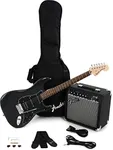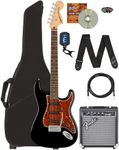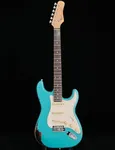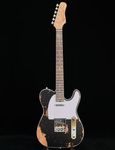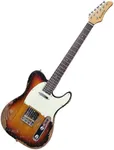Buying Guide for the Best Electric Guitar
Choosing the right electric guitar can be a thrilling yet daunting task, especially with the wide variety of options available. The key to finding the perfect guitar is understanding your own needs and preferences, and then matching those with the specifications of the guitar. Whether you're a beginner or an experienced player, knowing what to look for in an electric guitar will help you make an informed decision and ensure you get the best fit for your playing style and musical goals.Body TypeThe body type of an electric guitar affects its sound and playability. There are three main types: solid body, semi-hollow body, and hollow body. Solid body guitars are the most common and versatile, suitable for a wide range of music genres. Semi-hollow body guitars offer a warmer tone and are great for blues, jazz, and rock. Hollow body guitars provide a rich, resonant sound ideal for jazz and blues but are more prone to feedback at high volumes. Choose a body type based on the genre of music you play and the sound you prefer.
Neck ProfileThe neck profile refers to the shape and thickness of the guitar neck, which affects comfort and playability. Common profiles include C-shaped, U-shaped, and V-shaped. C-shaped necks are rounded and comfortable for most players, making them a popular choice. U-shaped necks are thicker and provide a solid grip, suitable for players with larger hands. V-shaped necks have a distinct ridge and are preferred by some lead guitarists for their unique feel. Consider your hand size and playing style when choosing a neck profile.
Scale LengthScale length is the distance between the nut and the bridge of the guitar, influencing string tension and tone. Common scale lengths are 24.75 inches (short scale) and 25.5 inches (long scale). Shorter scale lengths result in lower string tension, making bends easier and producing a warmer tone. Longer scale lengths have higher string tension, offering a brighter tone and more defined low end. Your choice should depend on your playing style and the type of music you play.
PickupsPickups are the devices that capture the sound of the strings and convert it into an electrical signal. There are two main types: single-coil and humbucker. Single-coil pickups produce a bright, clear tone and are commonly used in genres like rock, blues, and country. Humbucker pickups have a thicker, warmer sound with less noise, making them ideal for rock, metal, and jazz. Some guitars come with a combination of both types, offering versatility. Choose pickups based on the sound you want and the music you play.
Bridge TypeThe bridge of an electric guitar affects tuning stability and the ability to perform certain techniques. There are two main types: fixed bridge and tremolo bridge. Fixed bridges offer better tuning stability and sustain, making them suitable for most playing styles. Tremolo bridges allow you to change the pitch of the strings using a whammy bar, which is great for genres like rock and metal but can be more challenging to keep in tune. Consider your playing style and whether you need the pitch-bending capabilities of a tremolo bridge.
TonewoodsThe type of wood used in the construction of an electric guitar affects its tone and weight. Common tonewoods include alder, ash, mahogany, and maple. Alder and ash are often used for their balanced tone and moderate weight, making them versatile choices. Mahogany provides a warm, rich tone with good sustain, suitable for blues and rock. Maple is known for its bright, clear tone and is often used for necks and fingerboards. Choose tonewoods based on the sound characteristics you prefer and the overall weight of the guitar.
Fretboard MaterialThe material of the fretboard influences the feel and tone of the guitar. Common materials include rosewood, maple, and ebony. Rosewood fretboards offer a warm, smooth feel and a rich tone, making them a popular choice. Maple fretboards provide a bright, snappy tone and a smooth playing surface. Ebony fretboards are known for their smooth, fast feel and bright, articulate tone. Consider the feel and tonal qualities you prefer when choosing a fretboard material.

